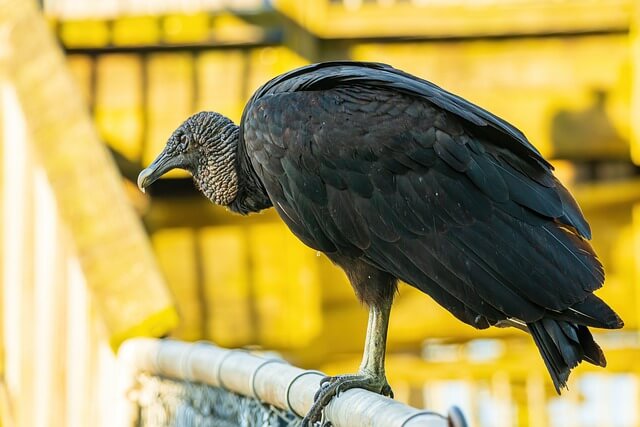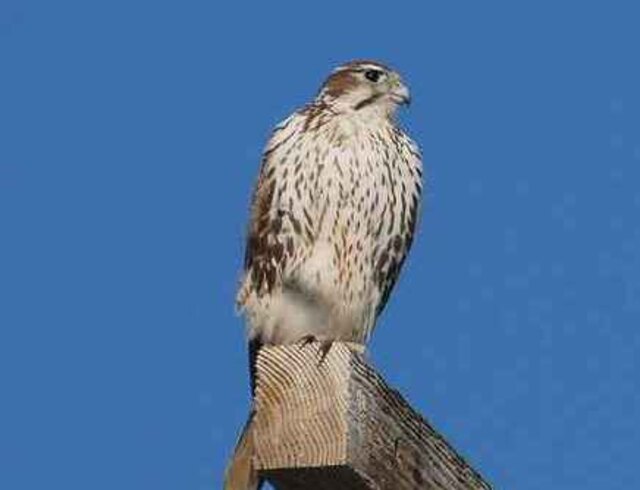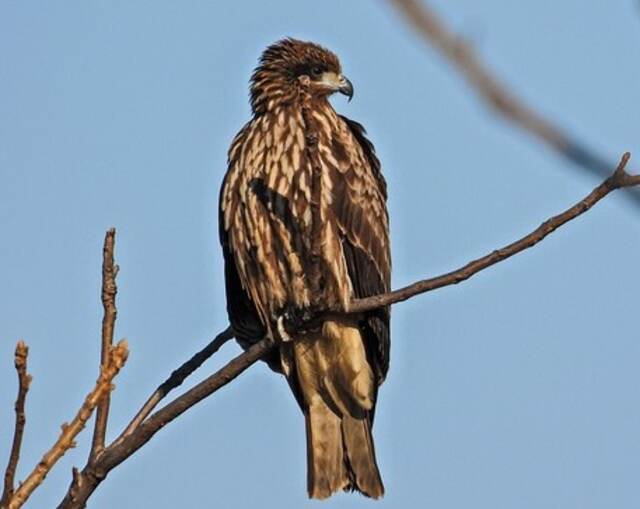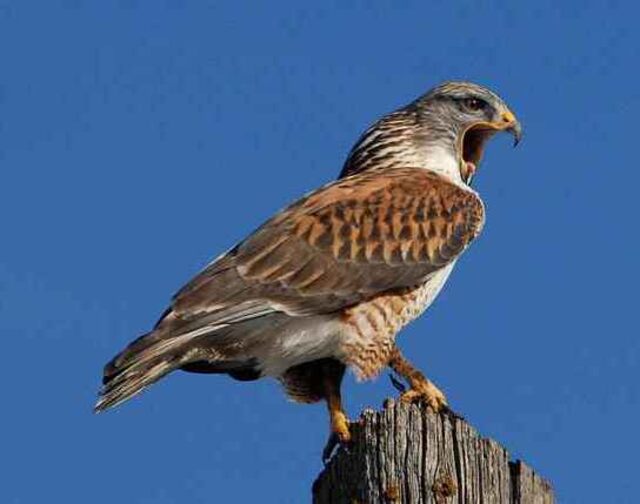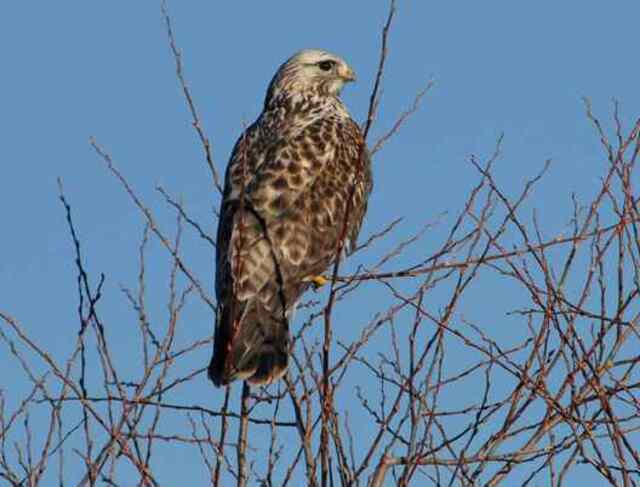Attention bird enthusiasts and nature lovers! Have you ever come across a majestic bird soaring high up in the sky and thought it was a bald eagle, only to realize it was actually a different species? Well, fear not! In this article, we will explore fifteen fascinating birds that share a striking resemblance to the iconic bald eagle.
Get ready to be amazed by the beauty and diversity of these birds, and learn how to tell them apart from their more famous cousin. So, let’s spread our wings and dive into the world of birds that look like bald eagles!
Table of Contents
Bald Eagle (Overview)
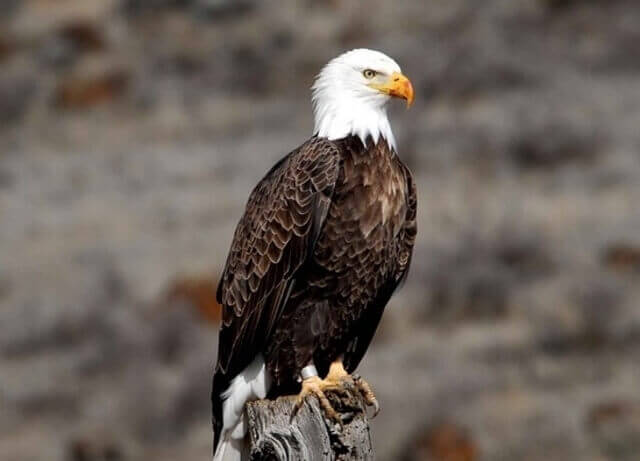
The bald eagle, one of America’s most iconic symbols, is a magnificent bird that embodies power, grace, and independence. This majestic creature can be found throughout North America, from Alaska to Florida, inhabiting a variety of habitats such as coastlines, lakes, rivers, and forests.
Habitat and Diet
Bald eagles are opportunistic predators, meaning that they eat a wide range of prey including fish, waterfowl, small mammals, and carrion.
Their keen eyesight allows them to spot prey from great distances, and their powerful talons enable them to capture and carry prey weighing up to four pounds.
Behavior and Social Life
Despite their impressive physical abilities, bald eagles are also known for their complex social behaviors, including courtship displays, territorial disputes, and cooperative breeding.
They are monogamous birds that mate for life, and their nests can weigh up to a ton and can be used for decades.
Conservation Status
The bald eagle’s significance goes beyond its natural history, however. The species was once on the brink of extinction due to habitat loss, hunting, and exposure to harmful chemicals such as DDT.
Thanks to conservation efforts, however, bald eagles have made a remarkable recovery and were removed from the endangered species list in 2007.
Birds That Resemble Bald Eagles
Given their cultural and ecological significance, it’s no wonder that many other birds are often mistaken for bald eagles. From the osprey’s distinctive plumage to the golden eagle’s powerful talons, each bird has its own unique features that make it resemble the bald eagle in some way.
Understanding the similarities and differences between these birds can deepen our appreciation of the natural world and help us better protect these majestic creatures for generations to come.
Birds That Look Like Bald Eagles
Red-tailed Hawk
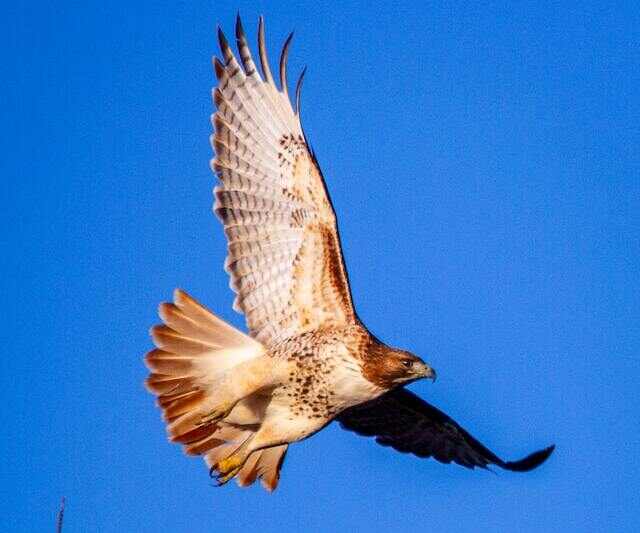
Red-tailed hawks are a common and widespread species found throughout North America, from Alaska to Panama. They prefer open habitats, such as grasslands, deserts, and farmlands, but can also be found in forests and urban areas. Their diet consists mainly of rodents, rabbits, and other small mammals, but they also eat birds, reptiles, and insects.
They are medium-sized raptors, with a wingspan of up to 56 inches and a weight of 1.5 to 3.2 pounds. They are easily identified by their reddish-brown tails, dark wings, and pale undersides. They are solitary hunters and often perch on high poles or trees to scan for prey.
In comparison to the bald eagle, the red-tailed hawk is smaller, with a shorter wingspan and lighter weight. They also have a different habitat preference, with the bald eagle preferring coastal areas and large bodies of water.
While both species have a similar diet of small mammals and birds, the bald eagle is known to also scavenge and feed on carrion. Bald eagles have a distinctive white head and tail, while the red-tailed hawk has a reddish-brown tail and pale undersides.
Additionally, bald eagles are known for their spectacular aerial displays during courtship, whereas red-tailed hawks are more solitary and less vocal. Despite these differences, both species are powerful hunters and play important roles in their ecosystems.
Read more: Interesting Red-Tail Hawk Facts
Golden Eagle

The Golden Eagle (Aquila chrysaetos) is a majestic bird of prey found throughout the Northern Hemisphere, from North America to Eurasia. These eagles prefer open and semi-open habitats, such as mountains, grasslands, and tundra. They primarily feed on mammals, such as rabbits, hares, and ground squirrels, as well as birds and reptiles.
Golden Eagles are one of the largest birds of prey in North America, with a wingspan of up to 7 feet and a weight of up to 13.5 pounds. They have dark brown feathers with golden highlights on their neck and head, and a powerful, hooked beak. Golden Eagles are known for their impressive hunting skills and can reach speeds over 150 miles per hour when diving for prey.
Although the Golden Eagle and the Bald Eagle (Haliaeetus leucocephalus) share a similar habitat and diet, they have some distinct differences in appearance and behavior. Bald Eagles are larger and have a distinctive white head and tail feathers, while Golden Eagles have a darker coloration with golden highlights.
Bald Eagles are primarily fish-eaters, while Golden Eagles tend to prey on mammals. Bald Eagles are known for their scavenging habits and can often be seen near water sources, while Golden Eagles are solitary hunters and tend to live in more remote areas.
Despite these differences, both species are powerful and impressive birds of prey that command respect and admiration from bird enthusiasts around the world.
Read more: 34 Interesting Facts About Golden Eagles (Detailed)
Turkey Vulture
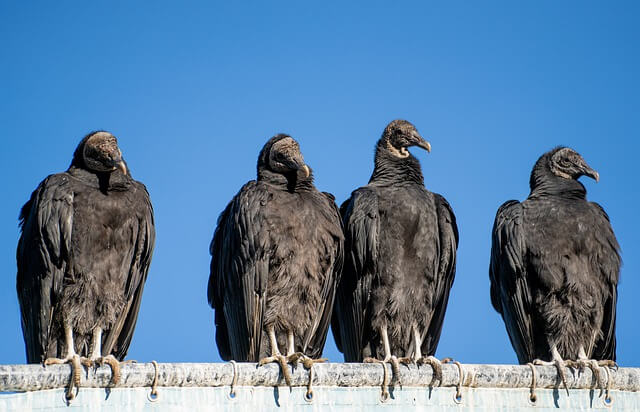
The Turkey Vulture (Cathartes aura) is a very large bird, with a length of 60–80 cm (23.5–31.5 in), wingspan of 160–180 cm (63–71 in), and weighing 1.0 to 2.40 kg (2.2 to 5.3 lb). This scavenger is found throughout North America, from deserts and grasslands to forests and urban areas, and is also found in Central and South America, Africa, Europe, and Asia, at any altitude up to 3100 m (10600 ft).
With its dark brownish-black plumage, long, broad wings, and distinctive red, featherless head, the Turkey Vulture is easily recognizable in flight. These social birds are often seen roosting in large groups and soaring effortlessly on thermals to conserve energy.
Although the Turkey Vulture and Bald Eagle (Haliaeetus leucocephalus) share a similar habitat range, they have notable differences in their diet, size, and appearance. The Turkey Vulture is a scavenger that feeds on carrion, using its keen sense of smell to locate dead animals. In contrast, Bald Eagles are predatory birds that feed primarily on fish.
The Turkey Vulture has a wingspan of up to 180 cm, while the Bald Eagle has a wingspan of up to 213 cm. Bald Eagles are also larger in size, weighing up to 7 kg, and have a distinctive white head and tail. In contrast, the Turkey Vulture has a darker plumage and a red, featherless head.
Despite their differences, both birds are impressive fliers, with the Bald Eagle known for its powerful, soaring flight and the Turkey Vulture for its effortless, gliding flight on thermal currents. Both birds are important members of their respective ecosystems and fascinating to observe in the wild.
Read more: 18 Facts About Turkey Vultures That Will Shock You!
Black Vulture
The American Black Vulture (Coragyps atratus) is a widespread bird of prey that inhabits the Americas, from the southern United States to southern Chile and Argentina. Measuring 55-75 cm (21.6-29.5 in) in length, with a 4.25-5.5 ft (52-66 in) wingspan, and a weight of 1.58 to 3 kg (3.5 to 6.6 lb), they prefer open habitats, such as forests, savannas, and wetlands, and are often seen soaring in the sky.
Their diet consists mainly of carrion, but they can also eat small mammals, birds, reptiles, and insects. Black Vultures have a black plumage with a featherless, wrinkled head that is grayish-black in color. They are highly social birds that often roost in large groups and perform communal soaring and gliding displays.
Compared to the American Black Vulture, the Bald Eagle (Haliaeetus leucocephalus) is a larger bird of prey that inhabits North America, from Alaska to Mexico. Bald Eagles measure up to 3 feet in length, with a wingspan of up to 7 feet, and a weight of up to 7 kg (15 lb).
They prefer areas near large bodies of water, such as lakes, rivers, and coasts, where they can fish for their main diet. Bald Eagles have a distinctive white head and tail feathers, with a dark brown body.
They are solitary birds that mate for life and build large nests on top of trees or cliffs. They are known for their powerful flight and hunting skills, and for being a national symbol of the United States.
Western Osprey

The Western Osprey, also known as the fish hawk, is a medium-sized raptor measuring 50-65 cm (19.6-25.5 in) in length and weighing between 1.0-2.0 kg (2.1 lb – 4.4 lb). They are found throughout North America, from Alaska down to the Gulf Coast, and prefer to inhabit coastal areas, lakes, and rivers.
Ospreys build large nests on high platforms or trees and have a wingspan of 125-180 cm (49-70 inches). Their diet consists mainly of fish, which they catch by diving into the water from high above. Ospreys are easily recognizable with their dark brown upperparts, white underparts, and distinctive facial mask.
They are known for their acrobatic flight displays and high-pitched, piercing calls. The Western Osprey shares some similarities with the Bald Eagle, such as their preference for coastal areas and diet of fish, but they also have some distinct differences.
While both birds have impressive wingspans, Bald Eagles are larger and heavier, with a wingspan of up to seven feet. Bald Eagles also have a distinct white head and tail, while Ospreys have dark brown upperparts and white underparts.
In terms of behavior, Bald Eagles are known for their powerful flight and impressive hunting skills, while Ospreys are more acrobatic and agile in the air. Overall, both birds are fascinating raptors with unique characteristics and adaptations that make them a delight to observe in the wild.
Read more: 18 Fun Facts About Ospreys You Didn’t Know
Prairie Falcon
The Prairie Falcon, scientifically known as Falco mexicanus, is a medium-sized bird of prey found in North America, from the western United States to northern Mexico. They prefer open grasslands, deserts, and sagebrush habitats, where they hunt small mammals, birds, and reptiles. Prairie Falcons are roughly the size of a crow, with a wingspan of around 3 feet.
They have a distinctive dark mustache-like mark on their face and pale underparts, while their upperparts are grayish-brown. These birds are agile and swift hunters, known for their aerial acrobatics and powerful dive-bombing attacks. Despite sharing some physical similarities with Bald Eagles, Prairie Falcons are quite different in terms of range, habitat, and diet.
While Bald Eagles are found throughout North America and near large bodies of water, Prairie Falcons are limited to the western half of the continent and prefer drier landscapes. Additionally, Bald Eagles are primarily fish-eaters, while Prairie Falcons hunt mainly small land animals.
In terms of appearance, Bald Eagles are much larger than Prairie Falcons, with a wingspan of up to 7 feet and a distinctive white head and tail. However, both species are skilled hunters and are known for their sharp vision, powerful talons, and impressive aerial feats.
Read more: 55 Facts About Prairie Falcons (Photos, ID & Details)
Andean Condor
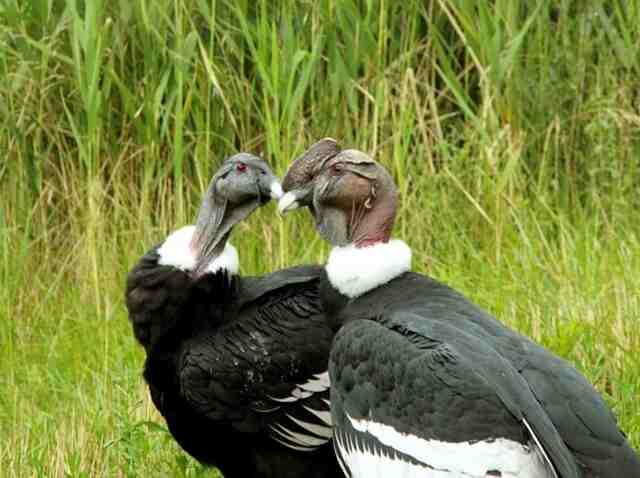
The Andean Condor (Vultur gryphus) is a magnificent bird of prey that inhabits the high Andes mountains of South America, from Venezuela to Chile. They prefer rocky and mountainous terrain, where they can take advantage of thermal updrafts to soar effortlessly through the air. Their diet primarily consists of carrion, but they will also eat small mammals, birds, and reptiles.
With a wingspan of up to 10 feet, the Andean Condor is one of the largest flying birds in the world. They have black plumage with a white collar and a distinctive bald head that can flush red during courtship displays. In terms of similarities and differences with the Bald Eagle, both species are large birds of prey that inhabit mountainous regions.
However, the Bald Eagle is found exclusively in North America, while the Andean Condor is restricted to South America. Bald Eagles prefer coastal habitats and freshwater bodies, while Andean Condors prefer high-altitude rocky areas.
The Bald Eagle primarily feeds on fish, while the Andean Condor is primarily a scavenger. The Bald Eagle has a brown body with a white head and tail, while the Andean Condor has a black body with a white collar and bald head.
Despite these differences, both species are majestic and impressive birds that inspire awe and admiration in bird enthusiasts around the world.
Read more: 18 Facts About The Andean Condor That Will Shock You
Black Kite
The Black Kite is a medium-sized bird of prey that can be found in Europe, Asia, and Africa. They prefer to inhabit open areas such as grasslands, fields, and wetlands, and can also be seen in urban areas scavenging for food. Their diet consists of a variety of prey including small mammals, birds, reptiles, and insects.
With a wingspan of up to 150 cm, the Black Kite has a dark brown plumage with a lighter head and neck. Their distinctive forked tail and yellow eyes make them easy to spot in the sky. They are known for their graceful soaring and swift, acrobatic flight, often seen in groups during migration.
In comparison to the Bald Eagle, the Black Kite has a much wider range, spanning across three continents. While both birds share a similar habitat preference, the Bald Eagle prefers to inhabit forested areas near water bodies.
The Black Kite has a more varied diet, including a larger proportion of insects and carrion. In terms of size, the Bald Eagle is significantly larger, with a wingspan of up to 244 cm. The Bald Eagle has a distinctive white head and tail, while the Black Kite has a more uniformly dark plumage, with only the head and neck being lighter.
While both birds are skilled hunters, the Bald Eagle is known for its impressive diving speed and strength, while the Black Kite is known for its agile flight and scavenging habits.
Read more: 47 Fun Facts About Black Kite (with Photos, ID & Details)
Northern Harrier
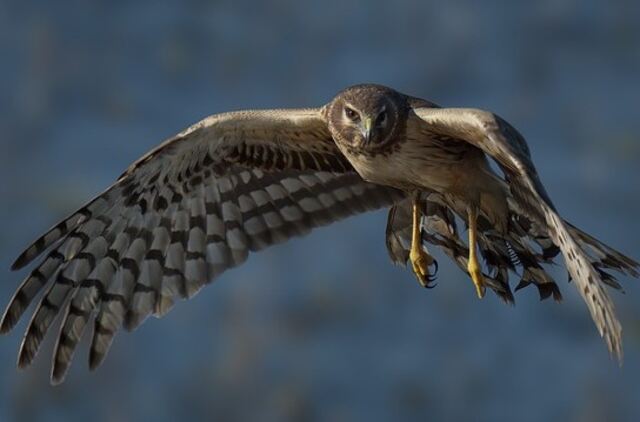
The Northern Harrier (Circus hudsonius) is a medium-sized raptor with a wingspan of 3.5 feet and a length of 18–20 inches. They have a distinctive white rump patch and are sexually dimorphic, with females having brown plumage and males being a lighter gray color. Found across the Northern Hemisphere, these birds prefer open habitats such as grasslands, marshes, and tundra.
They primarily feed on small mammals such as voles and mice, and will also eat birds and reptiles. Northern Harriers are known for their low, gliding flight pattern as they hunt and their characteristic behavior of “quartering” – scanning the ground for prey while flying back and forth in a zigzag pattern.
While both the Northern Harrier and Bald Eagle are raptors, they have many differences in their range, habitat, diet, size, appearance, color, habits, and behaviors. Bald Eagles are much larger, with a wingspan of up to 7 feet, and are easily recognized by their white head and tail feathers.
They are found primarily in North America near large bodies of water, such as lakes and rivers, and primarily feed on fish. In contrast, the Northern Harrier is found across the Northern Hemisphere in open habitats such as grasslands and tundra, and primarily feeds on small mammals.
While both species are known for their aerial hunting skills, Bald Eagles tend to soar at high altitudes while Northern Harriers have a low, gliding flight pattern. Despite their differences, both species play important roles in their ecosystems and are a testament to the diversity and adaptability of the raptor family.
Read more: Which Birds of Prey are the Quietest Fliers? Hear No Evil
Ferruginous Hawk
The Ferruginous Hawk is a large raptor that is found primarily in North America, ranging from southern Canada to northern Mexico. They prefer open grasslands and prairies for habitat and have a wingspan of up to 4.5 feet. Their diet consists mainly of small mammals, such as prairie dogs and ground squirrels, but they also occasionally feed on birds and reptiles.
Ferruginous Hawks are known for their light-colored, rust-colored feathers on their back and wings, while their head and underparts are white. They are territorial and mate for life, nesting in large stick nests built on cliffs or in trees.
In comparison to the Bald Eagle, the Ferruginous Hawk is slightly smaller and has a more reddish-brown coloration. While both species share a preference for open habitats, Bald Eagles are more commonly found near waterways and coasts.
Bald Eagles have a broader diet, including fish, mammals, and carrion, and are known for their distinctive white head and tail feathers.
Unlike Ferruginous Hawks, Bald Eagles are known to migrate long distances and also form communal winter roosts. Nonetheless, both species are powerful and impressive birds of prey that are a joy to observe in the wild.
Read more: 57 Ferruginous Hawk Interesting Facts (Photos, ID & Info)
Swainson’s Hawk
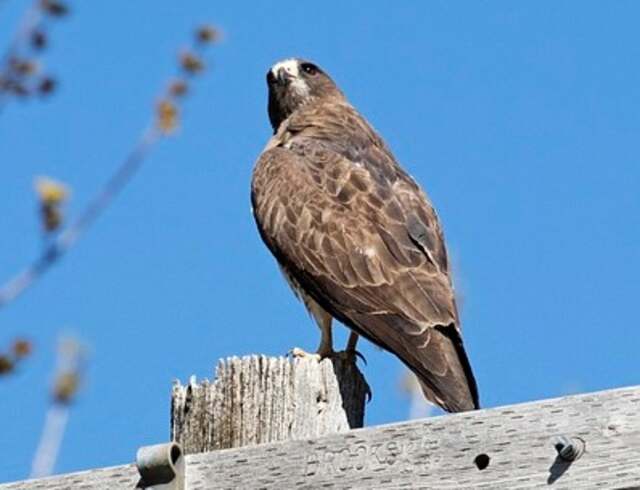
Swainson’s Hawks are medium-sized birds of prey found across North and South America. Their breeding range extends from western Canada to southern Argentina, and they are known for their long-distance migrations that can take them as far as the southern tip of South America. These hawks prefer open habitats such as grasslands, deserts, and agricultural fields, where they hunt for small mammals, birds, reptiles, and insects.
They have a wingspan of up to 4.5 feet and can weigh up to 3.5 pounds. Their distinctive features include a dark head, pale underparts, and a light-colored chest. Swainson’s Hawks are also known for their soaring flight and their habit of perching on poles and trees.
While Swainson’s Hawks share some similarities with Bald Eagles, such as their diet and habitat preferences, there are also notable differences between the two species. Bald Eagles have a much larger range, as they can be found across North America, Europe, and Asia.
They also prefer to live near water bodies such as rivers, lakes, and coasts, where they feed on fish and carrion. Bald Eagles are much larger than Swainson’s Hawks, with a wingspan of up to 7.5 feet and a weight of up to 14 pounds.
Bald Eagles have a distinctive white head and tail, dark body, and yellow beak and eyes. While both species are skilled hunters, Bald Eagles are known for their powerful talons and their habit of stealing prey from other birds.
Overall, while both Swainson’s Hawks and Bald Eagles are impressive birds of prey, they have their own unique characteristics and behaviors that make them stand out.
Rough-legged Hawk
The Rough-legged Hawk (Buteo lagopus) is a large bird of prey found in the Northern Hemisphere. They are highly adaptable and can be found in a variety of habitats, from open tundra and grasslands to wooded areas. They primarily feed on small mammals, such as voles and lemmings, but also prey on birds and insects.
Rough-legged Hawks have a wingspan of up to 55 inches and can weigh up to 3.5 pounds. They have a distinct white underside with black markings on their wings and a dark belly band. They are known for hovering over their prey before swooping down to catch it.
In terms of similarities and differences with the Bald Eagle, both birds share a similar range and habitat preference. However, Bald Eagles are much larger in size, with a wingspan of up to 8 feet and weighing up to 14 pounds.
They primarily feed on fish, but also prey on other birds and mammals. Bald Eagles have a distinctive white head and tail feathers, with a dark brown body. They are also known for their sharp talons and strong beak, which they use to catch and tear apart their prey.
Unlike Rough-legged Hawks, Bald Eagles do not hover over their prey, but rather dive down to catch it in midair or snatch it from the water’s surface. Overall, both birds are impressive predators with distinct adaptations that allow them to thrive in their respective habitats.
Peregrine Falcon
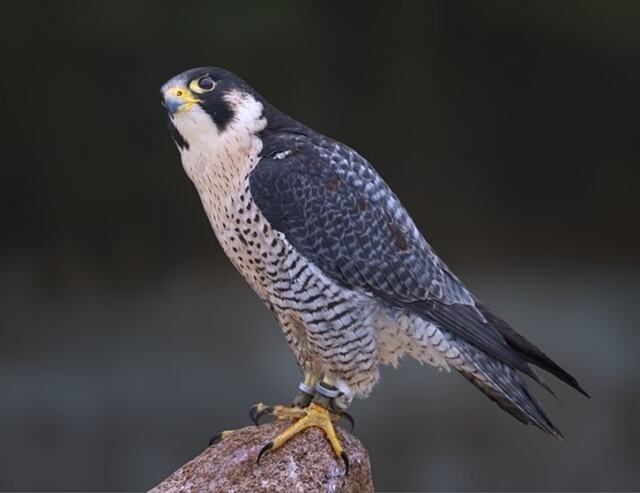
Peregrine Falcons have a global distribution, inhabiting every continent on the planet except for Antarctica. They prefer open habitats such as tundra, grasslands, and coastal cliffs, but can also be found in urban areas where they nest on tall buildings. They feed primarily on birds, with their hunting strategy involving high-speed dives known as stoops.
They are a medium-sized bird, with a wingspan of up to 4 feet and weighing up to 3.5 pounds. Their appearance is characterized by a dark head and back, white throat, and barred underparts. They are known for their speed, being the fastest bird in the world, reaching speeds of up to 240 mph during their dives.
While both the Peregrine Falcon and Bald Eagle are birds of prey, there are some notable differences between the two. The Bald Eagle is found only in North America, primarily near large bodies of water such as lakes and rivers.
Their diet consists of fish, but they also prey on small mammals and birds. They are a larger bird than the Peregrine Falcon, with a wingspan of up to 7.5 feet and weighing up to 14 pounds. Bald Eagles are easily recognized by their dark brown body feathers and distinctive white head and tail feathers.
They are also known for their habit of stealing food from other birds and their tendency to mate for life, building large nests in trees or on cliffs.
Read more: 36 Interesting Facts About Peregrine Falcons (Detailed)
Cooper’s Hawk
The Cooper’s Hawk is a medium-sized bird of prey found across North America, from southern Canada to northern Mexico. They prefer to live in woodlands, forests, and suburban areas where they can hunt for their prey. Their diet consists of smaller birds, mammals, and insects, which they catch with their sharp talons and hooked beak.
The Cooper’s Hawk is about the size of a crow, with a wingspan of up to 3 feet. They have a slate-gray back and wings, with a rusty-red barred breast and white underparts. Their sharp eyesight and agile flight make them a skilled hunter, often chasing their prey through trees and shrubs.
In terms of similarities and differences to the Bald Eagle, the Cooper’s Hawk is much smaller in size and has a different range and habitat preference. While Bald Eagles prefer to live near bodies of water, Cooper’s Hawks live in woodlands and suburban areas.
Additionally, while Bald Eagles primarily eat fish, Cooper’s Hawks prefer to eat smaller birds and mammals. However, both birds are skilled hunters with sharp talons and hooked beaks, and both have impressive wingspans.
Unlike Bald Eagles, Cooper’s Hawks are known for their agile flight and ability to chase their prey through trees and shrubs. Overall, both birds are fascinating predators with unique traits and behaviors.
Read more: 20 Cooper’s Hawk Fun Facts (with Photos & Information)
Northern Goshawk
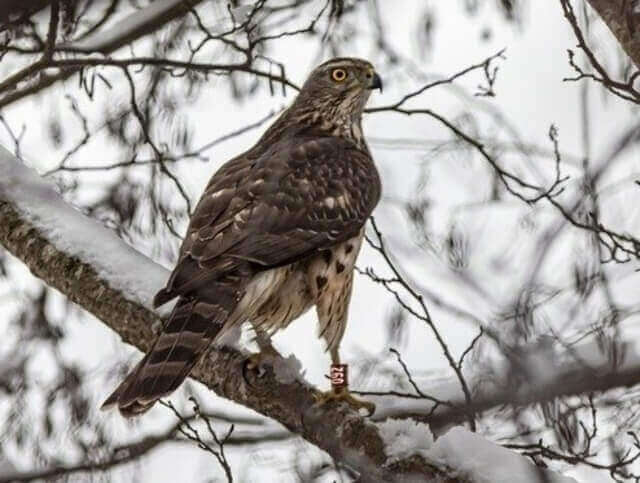
The Northern Goshawk, Accipiter gentilis, is a powerful raptor that inhabits forests across the Northern Hemisphere, from Alaska and Canada to Europe and Asia. This bird of prey prefers mature, coniferous forests with dense understories where it can hunt its prey of choice: birds, small mammals, and occasionally reptiles or fish.
With a wingspan of up to 3.5 feet and a weight of 2 to 4 pounds, the Northern Goshawk is a medium-sized hawk with short, broad wings and a long tail. Its plumage varies between dark gray and brown, with bold white spots on its undertail coverts.
The Northern Goshawk is an expert hunter and can fly through dense forests with incredible speed and agility, surprising its prey with sudden attacks. While the Northern Goshawk and the Bald Eagle both belong to the Accipitridae family and share some similarities, they have many differences.
The Bald Eagle is a much larger bird, with a wingspan of up to 7 feet and a weight of 6 to 14 pounds. It inhabits a wider range, from North America to northern Mexico and along coastlines and large lakes and rivers.
Unlike the Northern Goshawk, which prefers dense forests, the Bald Eagle can be found in various habitats such as coastal wetlands, tundra, and prairies. The Bald Eagle feeds mainly on fish, but also scavenges on carrion and preys on small mammals and birds.
Its plumage is mostly dark brown with a white head and tail, and it has a distinctive yellow beak and piercing eyes. While both birds are impressive predators, the Bald Eagle is known for its majestic appearance and symbolism as a national bird in the United States.
Read more: 48 Northern Goshawk Fun Facts (The Ultimate Guide!)
Observations and Experiences
As an avid bird watcher, I’ve had the privilege of observing many birds that look like bald eagles in the wild. One of my favorite spots to see these birds is along the coastline, where they soar effortlessly over the waves, scanning the water for fish.
One bird that stands out to me is the osprey, which is often mistaken for a bald eagle due to its similar coloring and impressive wingspan. But while bald eagles are primarily scavengers, ospreys are skilled fishers, plunging headfirst into the water to snatch their prey with their sharp talons.
Another bird that resembles a bald eagle is the golden eagle, which can be found in mountainous areas throughout North America. While both birds have a similar silhouette and regal appearance, the golden eagle is actually more closely related to hawks and falcons than to bald eagles.
Further Reading and Resources
If you’re interested in learning more about birds that look like bald eagles, there are plenty of resources available to help you become a better birder. Here are some of my favorites:
- The Cornell Lab of Ornithology’s All About Birds website has detailed information and photos of hundreds of bird species, including many that resemble bald eagles.
- The American Birding Association offers birding guides, courses, and events for bird enthusiasts of all levels.
- The National Audubon Society is a nonprofit organization dedicated to bird conservation, with local chapters and volunteer opportunities across the country.
Conclusion
In conclusion, there are many birds that look like bald eagles, each with their own unique characteristics and behaviors. By understanding the differences between these birds, we can appreciate the diversity of the natural world and become better stewards of our planet. So get outside, grab a pair of binoculars, and see how many birds that look like bald eagles you can spot!
Related Post: 47 Interesting Facts About Bald Eagles: A Complete Guide!


